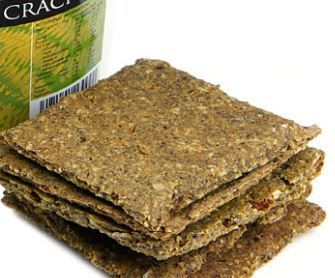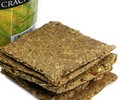Enzyme ACTivated Crackers
The aptly named EATRIGHT® Enzyme Activated Crackers are a crack'er of ingenuity with carefully pre:served enzymes. Importantly, they are NOT [a "JACK" up, hiJACKed [1] or "overPOWERing...paired...crackers"] that have "microbial enzymes" added back to an ingredient list.
Hence, we use slow and low processing (never above 121 degrees celsius or 248 degrees fahrenheit), and other maximize 'nutritional value' know-how to help enzymatic [*] (Gk. en within, zumē leaven) activity.
And since organic catalysts or catalyzing enzymes are 'dramatically enhanced by abiotic agents' (ozone, UV light, ethylene, salicylic acid (nb. non-isolated salicylate sources: buckwheat, piper sp.), minerals (soil nutrients such as chromium, copper, boron, manganese etc)), we source as many as possible grown outdoors in NEW ZEALAND's 'more sun [UVB in particular], less air pollution, fewer pest and diseases' harvested ingredients.
The minerals and vitamins are also considered to be “better absorbed” through synergistic combinations of endogenous enzymes rather than synthetic ‘silver bullet’ single cell proteins (SCP) or other 'isolates'. And, where possible, we use 'wild' varietals. For instance, wild carrots have an increased source of phytochemical: trans-isoasarone with bioactivity: secretolytic (secretagogue (Gk. agogos)) and wild kawakawa (Macropiper excelsum [Latin: pipo=chirp, excel=surpass]) has over 60 biologically active compounds.
As you would expect, it is yet another durable [2], commercialized EATRIGHT® ‘edible medicine’ innovation scarcity (R&D&C), standing out in a sea of similarity! [†]. And did you know "the doctor of the future will give no medicine, but will instruct his patients in care of the human frame, in diet and in the cause and prevention of disease" by Thomas A. Edison (1847-1931).
NUTRITION INFORMATION: Serving Size Unit of Measure (UOM) 20g (0.7oz) (1 cracker)
(By calculation. Increases (>) or decreases (<) postulated from proximate product (P)).
Energy 462kJ (110Cal)(3%DI), Protein (2.8g)(5%DI), Protein-gluten (0g), Fat-total (<4.4g)(6%DI), Fat-sat (0.4g)(2%DI), Fat-trans (0g), Fat-poly (2.1g) (omega-3 (5mg), ALA (2mg)), Fat-mono (1.5g), Cholesterol (0g), CHO-total (<3.3g)(1%DI), CHO-sugars (<0.3g)(0%DI), Dietary Fiber [improved soluble : insoluble ratio] (>1.4g)(5%DI), Sodium (8mg)(0%DI), Calcium (>9mg)(1%RDI), Iron (0.6mg)(3%RDI), Potassium (70mg)(1%RDI)
Thiamin (0.2mg)(17%RDI), Vitamin B5 (0.1mg)(10%ESADDI), Magnesium (33mg)(8%RDI), Folate (16µg)(8%RDI), Manganese (329µg)(7%ESADDI), Niacin (>0.9mg)(6%RDI), Vitamin A (34.8µg)(5%RDI), Phosphorus (<67mg), Selenium (2.3µg)(4%ESADDI), Riboflavin (0.1%)(4%RDI), Zinc (0.5mg)(4%RDI), Vitamin E (>0.6mg)(4%RDI), Vitamin C (0.3mg)
Essential Amino Acids (705mg), Amino Acid Combinations 76mg (methionine, cystine), 147mg (phenylalanine, tryosine)
ABBREVIATIONS: The percent Daily Intake (%DI), Recommended or Reference Daily Intakes (%RDI) and Estimated Safe and Adequate Daily Dietary Intake (%ESADDI) tells you how much a nutrient, in a serving of food, contributes to a daily diet. An average adult diet of 8,700KJ or 2,000 calories a day is used for general nutrition advice.
Enzyme Commission (EC) Number: classifies enzymes based on their catalytic reaction
American Type Culture Collection (ATCC) Number: used to identify a prokaryote
Protease USP (Ubiquitin Specific Protease)
INGREDIENTS: Unhulled Seeds (Cert Organic Silverhull Buckwheat, Cert Organic Sunflower, Cert Organic Linseed [††]), Cert. Organic 'Grain Free' Brown Rice Grist, Cert. Organic Carrot, Native New Zealand Herbs [^] (they include: 'mountain scree' Horopito ("a hard-to-find specialty...(bush) pepper") or 'pepperwood', 'lowland divaricating' Kawakawa (bush basil), 'pepper tree' [3]; they may include Harakeke (native flaxseed, chitin 1.44mg/100g)) and others, as more active properties are uncovered).
[*] ENZYMES: Current identification includes 703 in rice, 108 in carrots, 101 in sunflowers, 20 in buckwheat and 1 in harakeke (EC 7.1.2.2. 'H+-transporting two-sector ATPase'). No enzymes conclusively identified for Horopito, Kawakawa [^^], Wharaiki et al. ('Remarkably, some 15-20% of the known native New Zealand seed plants are still undescribed or need to be critically examined' [^]). Please note: the enzymes maybe specific to a part of the plant which is not used or activated in this product. Source data: BRENDA, the ELIXIR. Nucleic Acids Res. by Schomburg D et al (Jul'07, pub. 21)
[**] N.B. NO food additive number 450 ‘sodium SALTS of phosphoric acid’ or any other ‘prepared synthetics’. See eg ‘450 prepared synthetics’ (digestive disturbance, blockage of a number of enzymes): sodium polyphosphates, pentasodium triphosphate (sodium tripolyphosphate), (no chloride, low salt index) potassium polyphosphate and pentapotassium triphosphate (potassium tripolyphosphate). And no '541' sodium aluminium phosphate, ACIDIC...aerator or 'E541' sodium aluminium phosphate, BASIC...emulsifying salt (see eg 'salt' in cheese), 'not permitted in Australia'. Ref: Additive Code Breaker by Hanssen, M (pub. '84). And no "leavening agents, baking, double-acting, straight phosphate". USDA PRAL Value 270.164 mEq/100g (cross ref: SR Legacy. FDC 172804. NDB 18369. FDC pub. 1st Apr’ 19).
Country of Origin: Made in NEW ZEALAND from NEW ZEALAND and imported ingredients
Detail: Food Safety Verification Certificate Number 2699 (an International Accreditation NEW ZEALAND (IANZ) inspection body audit, pursuant to the Food Act 2014) issued to Eat Right Food Ltd for the manufacture, processing, packing, holding, distribution and exporting of food products
Availability: Sold 'exclusively' as an EATRIGHT® online shop only product
Address: PO Box 1525 (Level 1, 6 Church St), Nelson 7040, NEW ZEALAND
Shelf life: Excellent shelf stability. No cyroprotectants needed. And 'best before' label dates doesn't mean 'throw away after'
Processes include: Temp = Slow; Time = Moderate, removal of 'double feature' seed pods and other intricate steps
Packaging: Stand-up, safety seal, reseal zipper packs. Home compost-in-bin-able film.
[†] A non 'identical' product that was gemmated ('privately available' label proof) late 2008 now 'publicly available' (~ $1(R), $10(D), $100(C)). Stands out compared to: (sprinkled with salt) 'saltine cracker[s]', (made of water and wheat) 'water cracker[s]', 'entertainment cracker[s]', 'seed crackers...everything (but native herb) seasoning', 'contextual' supplements and pharmaceuticals.
Product Details
- Phospholipidase-inhibitor (anti-PLA activity): phytochemID: quercetin. Plant sources: buckwheat seed, pepper. Dr Duke's Phytochemical eDatabases ('16)
- Carrot source: EC 1.10.3.2 Laccase and EC 3.2.1.14 Chitinase (cleaves glycosidic linkages in chitin and chitodextrins...generating chitooligosaccharides and free ends on which exo-chitinases and exo-chitodextrinases can act) BRENDA, the ELIXIR data. Nucleic Acids Res. by Schomburg D et al (Jul'07, pub. '21)
- Rice source: EC 3.1.3.48 Protein Tyrosine Phosphatase (PTPase), EC 3.1.3.16 HMG-CoA reductase phosphatase, EC 3.4.22.34 Legumain, EC 3.4.22.49 Separase and many others. Nucleic Acids Res. by Schomburg et al (pub. '21)
- Ubiquitin: a regulatory protein. Was originally known as ubiquitous immunopoietic polypeptide. Ubiquitination/ubiquitylation (3 step: activation E1, conjugation E2, ligation E3). (ref: Wikipedia). NB. a food activated product not whole[en]ZYME suppleMENTation with four 'additives' (460, rice, 464, 'prepared synthetically' 572, 551)
- EC 6.3.2.19 (deleted 2015). Now starting EC 6.2.1.45 (E1) followed by several transfer reactions including EC 2.3.2.23 (E2) and EC 2.3.2.27 (E3) (BRENDA, pub '21). 'E2-E3 ubiquitin enzyme pairing - partnership in provoking or mitigating cancers' by Shu-Chun Chang et al (pub. Jan ’22)
- Fungi 'may be mutually beneficial (mutualistic), benign or non-harmful to the other partner (commensal) or harmful to the other partner (parasitic)' NZ’s Genetic Diversity by Gordon D.P (pub. '13)
- Carrot source: Biological activity: Ferulosys-genic. Phytochem: falcarindiol (FaDOH). anti-fungal, anti-inflammatory et al
- Buckwheat activity: cAMP (cyclic adenosine monophosphate) -phosphodiesterase-inhibitor. 468,900ppm non-ubiquitous phytochemicals: (+)-catechin, orientin, quercetin, rutin, vitexin. EC 3.2.1.B31 beta-rutinosidase, EC 3.2.1.40 alpha-L-rhamnosidase, EC 3.2.1.20 alpha-glucosidase et al.
- Bacillus circulans (ATCC 31382) NOT added (FSANZ §18-4). And NO phytates added as 'microbial nutrient adjuncts'.
- Linseed source of: phenolic acid: 810ppm-103,400ppm, phenolic acid esters: 739ppm-5,420ppm. Phenol coefficient no longer used due to differences related to 'temperature, pH, surface activity, and interfering substances'
- Salicylates: Bioactivities: antiaggregant, antiinflammatory, antipyretic, antiuricosuric, hyperglycemic, hypoglycemic, uricosuric. Uricosuric: promotes the excretion of uric acid (FEUA). Gout: high uric acid levels leading to uric acid crystal formation in joints.
- Piperine is an adrenergic secretagogue, enhancing the secretion of catecholamines, especially epinephrine, from the adrenal gland, thereby leading to a warming sensation' Dr Duke's Phytochemical Databases (pub. '02)
- Piper excelsum (piperaceae) kawakawa. Ethnobotanical uses: New Zealand include kidney, diuretic, urogenital et al. Uphof, J.C. Th. 1968. Dictionary of economic plants. 2nd ed. Verlag von J. Cramer
- Activities: Anticoagulant. Buckwheat: 16,400ppm from (+)-catechin, citric acid. Carrot: citric acid, heraclenin. Sunflower: 3,800ppm citric acid (Merck 11th ed) and Piper sp. NB. Non-Aspirin and Non-Acetylsaliclic Acid sources. [††] Aspirin: Enteric Coated, Micro Coated, Low/Regular Strength included in Safeway Celiac Sprue Gluten Free Products List 2009
- (P) Buckwheat germination. Increased: phenolic compounds, flavonoids, crude protein, antioxidant activities (Zhang et al. '15). Decreased: sugars, phytic acid (activation of phytase, hydrolyzes phytic acid into phosphoric acid & myoinositol making minerals more bioavailable) (Liang et al '08; Mbithi-Mwikya et al '00), trypsin inhibitor activity (TIA), crude fat (Zheng et al '06)
- (P) Rice germination one of a number of proprietary processing steps. Increased crude proteins, niacin, free amino acids, and α-tocopherol by Moongngarm & Saetung (2010)
- (P) Increased: protein content 17.76%, total dietary fibre 8.76%, antioxidant activity 29.1%, total phenolic 134.43%. Decreased: fat content 36.46%, carbohydrate 7.23%. Raw lambsquarters (FDC ID 169244 'SR legacy') germinated (cookie product) by Jan, R., Saxena, D. C., & Singh, S. (pub. 2017)
- [††] Non-Tropical Plants Yielding Clinically Useful Drugs. Drug: ◀Nordihydroguaiaretic Acid▶. Action/Clinical Use: Antioxidant. Plant: Linseed [also Larrea divaricate Cav]. Farnsworth, N. R. & D. D. Soejarto. 1988. Global importance of medicinal plants (unpublished draft manuscript rev. 23).
- [†††] NO added sugar beet: indication Water Retention (1; KAB; WO2). Overdoses might cause hypocalcemia, kidney damage, and oxalate-toxicity (PH2). KAB: Kirtikar and Basu (reprint, 1975); WO2: The Wealth of India, revised; new vol. pub. (1985–1992); PH2: Gruenwald et al. (2000)
- [1] See 'hiJACK...taking over any proceedings that have already begun...'Red Herrings and White Elephants (nonfiction) by pen-name Albert JACK (pub. '07). See also doc. 32-2 (pub. Apr'14 incl. eg use by '10), MSJ (Mar'15) and 'valuable facts are unavailable...restricted by conduct that impedes, bars...raises the cost of access' (to 'superior' products) by Gravil A.I.
- [2] durable, a. Capable of lasting. dura mater n. (anat) outer membrane of brain (cf. pia mater). [L durus hard]. mater'ia med'ica n. drugs, pharmacology. matériel n. the available stores for an undertaking [L materia timber]. Oxford Dictionary (pub. Jul'24, reprinted with corrections '52)
- [3] Key Messages - Natural Health Products Sector. NEW ZEALAND Story. 'Made with Care' New Zealand Trade & Enterprise (NZTE) initiative (Oct'20). Another NZ company sold 'mussels in...horopito' and 'mussels in...kawakawa' in 'PNOS' California stores in 2010.
- [^] 'A biota of 52 517 native species...seed-plant flora show a number of unusual features'
New Zealand’s Genetic Diversity by Gordon D.P (pub. 2013, NIWA Research). Differs to 'New Zealand is NOT rich in native plant foods' (Reader's Digest (Australia) A-Z Guide pub. 1997, reprint 2002)
- 'Enzymatic effects on nutrient availability...food design based on an understanding of digestive processing'
Human digestion – a processing perspective by Mike Boland (pub. Dec’15) [institution req'd access]
- [^^] ‘Likely…action of piperine synthase (piperoyl-CoA:piperidine piperoyl transferase [EC 2.3.1.145]), or related enzyme, piperamide'. See also 1g 'dried leaf powder…8.0 µmol elemicin and 7.1 µmol [amphetaminagenic] myristicin…all <1%' toxicity concentrat
Exploring the Chemical Space of Kawakawa Leaf (Piper excelsum) by: Jayaprakash R et al (pub. Dec ’22)
- Most abundant: pellitorine (gastrointestinal (COX-1-Inhibitor,Cyclooxygenase inhibitor)), yangambin (reduces inflammation), dopamine (regulate insulin response)
Acute Effects of Kawakawa (Piper excelsum) Intake on Postprandial Glycemic and Insulinaemic Response in a Healthy Population by Ramsan et al (pub. Apr '22)
- “ALT” alanine transaminase (EC 2.6.1.2) (rice source, pH8) 'located in liver cells that leak out into the general circulation when liver cells are injured
(previously known as the SGPT (serum glutamic pyruvic transaminase))'. Encyclopedia of common natural ingredients & Brenda-Enzyme resources
- Matrix metalloproteinases are “calcium dependent, zinc containing endopeptidases…expressed as zymogens [or proenzymes], subsequently processed by other proteolytic enzymes (such as serine proteases (EC 3.4.21…present in rice, sunflower seeds and carrots))
Matrix metalloproteinases (MMPs): chemical-biological functions and (Q)SARs by Verma R. P. et al (epub. Jan’17)
- Piperidine alkaloid biosynthesis. phenyllactate UDP-glycosyltransferase (UGT) enzymes (E 2.4.1.-)
and malic-, succinic-, acetic- acids (carrots, sunflower, linseed (3105-3853ppm)) for rutin hydrolysis (deglycosylation) to bioactive↑ quercetin-3-glucoside (isoquercetin) pubchemID: 5280804.




